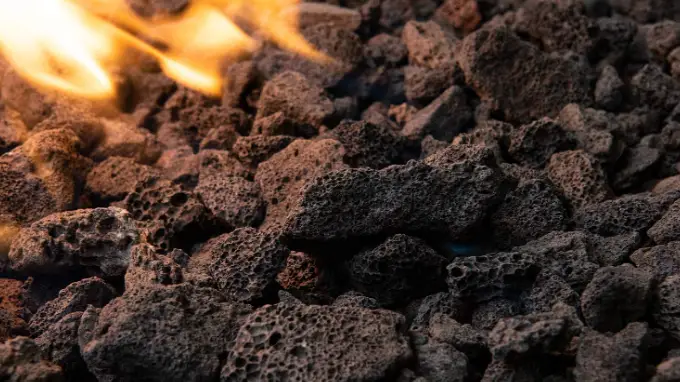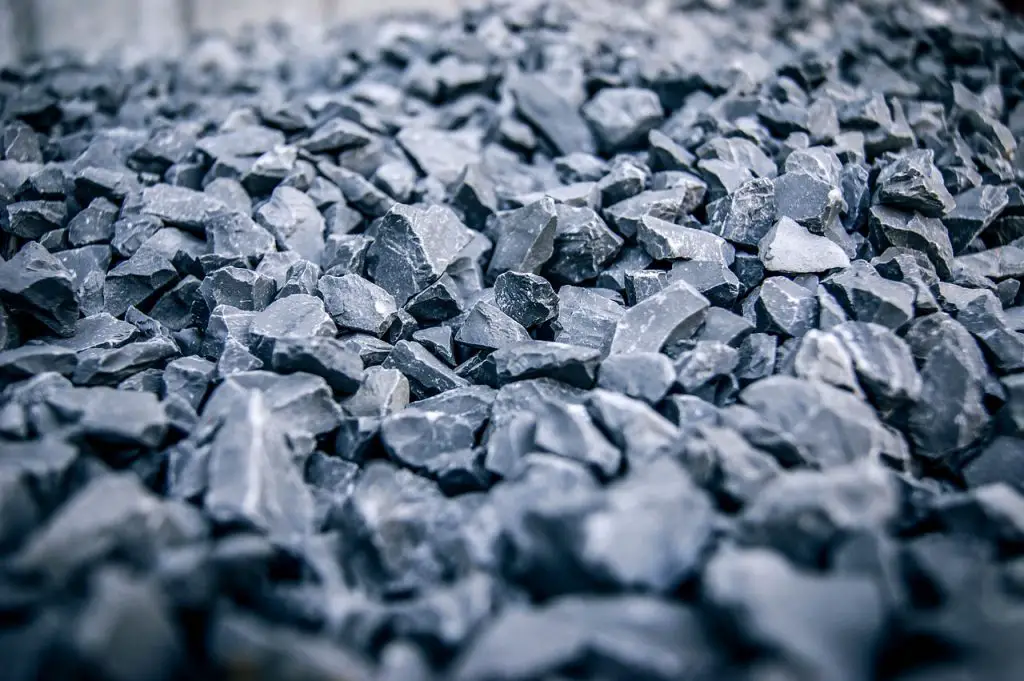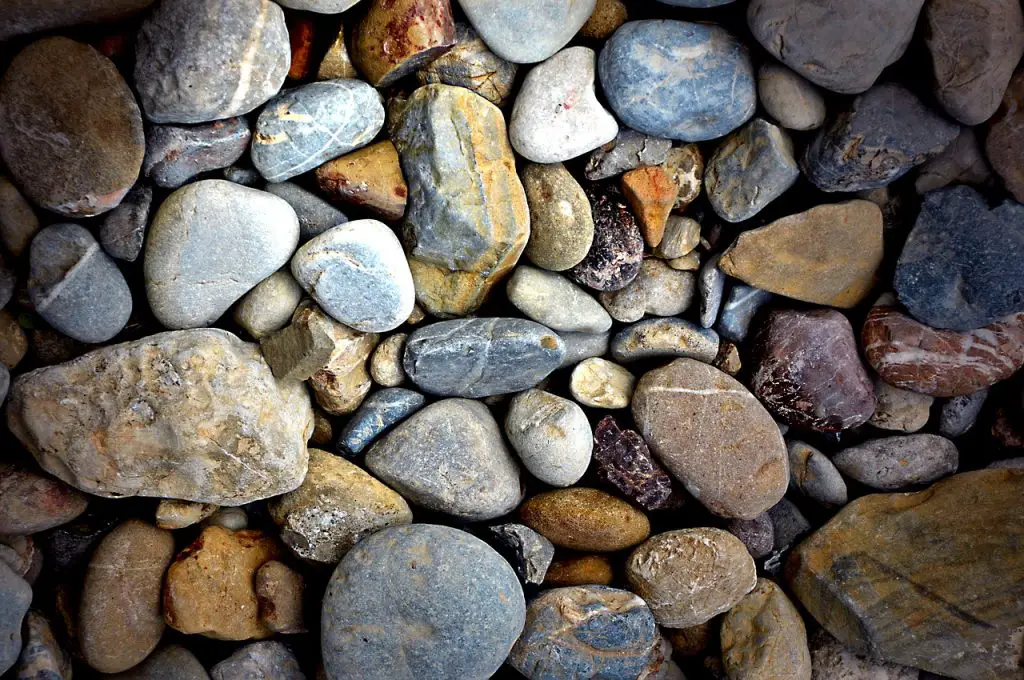What you find on this page:
Fire pits are the perfect place for friends and family to gather and enjoy each other’s company in a comfortable setting. The makeup of the fire pit and the materials used to landscape the area around the fire pit can determine the overall atmosphere and feel of the gathering.
Understanding what the best rocks for a fire pit are may make all the difference when it comes to the enjoyability of your fire pit.
What to Put in the Bottom of a Fire Pit?
The material you use at the bottom of your fire pit is arguably the most important decision you will make in regards to fire pit functionality. The last thing you want to do is use a substance or rock type that cannot withstand the heat of the fire or the natural, outdoor elements. Lava rock, sand, fire pit glass, and dirt are the best substances to use at the bottom of your fire pit.
Keep reading to learn how to build a fire pit with rocks in a safe and aesthetically pleasing way.

Lava Rock
Lava rocks are some of the best rocks for fire pits. Lava rock is not only aesthetically pleasing, but it can withstand temperatures up to 2,000 degrees Fahrenheit. Hence its name, lava rocks are formed by the heat of lava flowing deep inside the earth.
They are porous rocks and only hold the heat for approximately 20 minutes. This makes it an optimal choice for the bottom of your fire pit because the cooling period of the fire pit is short once the fire is extinguished.
How Long Do Lava Rocks Last in a Fire Pit?
While lava rocks are one of the most suitable rock options for the bottom of your fire pit, after years of extended exposure to high temperatures, they begin to show signs of wear and deterioration.
Lava rocks in a fire pit will typically last for two years. The best way to determine when it is time to get new lava rock is when they start to crumble easily. You can extend the life of your lava rocks by refraining from moving them around and scratching each other and preventing them from staying wet for a long period.

Sand
Sand is another excellent option for the bottom of your fire pit. Sand not only gives a clean, uniform look to your fire pit, but it also acts as an insulator. The sand absorbs the heat from the fire and distributes it throughout the fire pit. This means that even if the fire is visible on only one side of the pit, the other side still benefits from the fire.
Fire Pit Glass
As the name implies, fire pit glass is specifically designed to perform as a layering material for your fire pit. Although it is on the higher end of the price tag, fire pit glass can withstand extreme temperatures, and the chance of the glass exploding is virtually zero. Firepit glass comes in various shapes, colors, and sizes, meaning you can find the perfect type to fit your fire pit style. You can layer fireplace glass rocks with logs for a larger flame.
Dirt
Dirt is a cost-effective material to use for the bottom of your fire pit. While dirt is readily available and easy to obtain, its heat resistance is not comparable to that of fire pit glass, sand, and lava rock. Dirt must be replaced or refilled in the fire pit regularly to ensure the pit is up to par to contain the fire.
Even though it doesn’t hold the same heat resistance as other materials, dirt is an easy and inexpensive way to line the bottom of your fire pit.

Rock Types You Should Avoid Using
Just as particular rock types make an excellent bottom for a fire pit, other rock types should not be used. These rock types are typically softer and have a porous makeup allowing liquid to seep into them. When you mix extreme heat with soft, liquid-filled rock, it can explode, causing a potential hazard to those sitting around the fire.
Gravel
Gravel is made up of limestone rock. Limestone is composed of small fossils and shell fragments and contains calcite and dolomite. The porous nature of gravel makes it crumble easily and become susceptible to liquid penetration. If gravel meets extreme heat, it is likely to explode because of the soft, porous makeup.
River Rock
While river rock contains an aesthetically pleasing appearance, they are not the ideal rock for the bed of a fire pit. River rocks have smooth, rounded edges as a result of the gushing waters of the river from lying in the river bed for years.
Because of years of water erosion that forms these rocks, they are likely to contain water. When the water-filled rocks are met with extreme heat, they can explode and become very dangerous for anyone nearby. This is a common fire pit mistake.

Pumice Stone
Pumice stone has a porous texture and is light with fragile construction. Because the porous texture results in a fragile stone, pumice is likely to hold air and water pockets if exposed to outdoor elements. When these pockets are met with the heat of the fire, it can result in exploding rocks. Therefore, a pumice stone fire pit is not a good idea.
Natural Rocks
As with the previously stated rock types to avoid using in a fire pit, natural rock has the same consistency. The softness of natural rock is susceptible to the absorption of water and other natural elements. Using a rock type that contains liquid is not ideal for fire pits because the heat causes them to pop.
Pebbles
Pebbles in a fire pit are another option you should avoid. While they are aesthetically pleasing, pebbles are soft, making them susceptible to water absorption. As previously mentioned, this makes them more likely to pop or explode in the fire.

What to Put Around a Fire Pit?
While the types of rock you can and cannot use inside the fire pit are determined by the genetics of the rock, the material you put around the fire pit is more focused on the look you are trying to accomplish. You do not need fire brick for a fire pit, but it is one of many alternative options available.
Pea Gravel
One of the key benefits of using pea gravel for your fire pit is its efficiency. Pea gravel is not expensive, and it provides a comfortable and clean look to the fire pit area. The convenience of pea gravel makes it an excellent fire pit rock.
Flagstone
Considered the ideal rock for fire pit landscaping, a flagstone fire pit area is an excellent material to prevent the spread of an escaped fire. Flagstone is non-porous, meaning it will not hold water like pea gravel, limestone gravel, and river rock. It is also easy to remove ash from the area, and you don’t have to worry about replacing rock that washes away.





